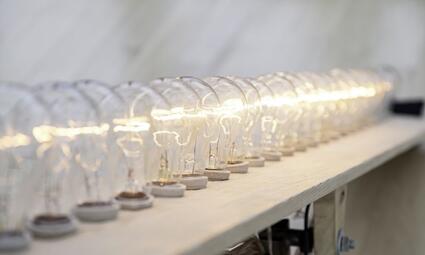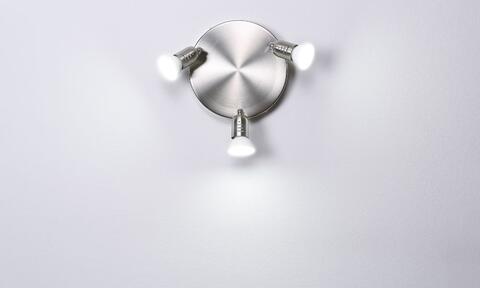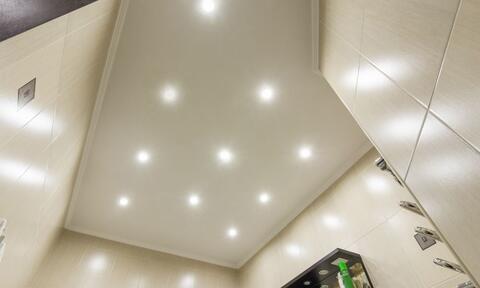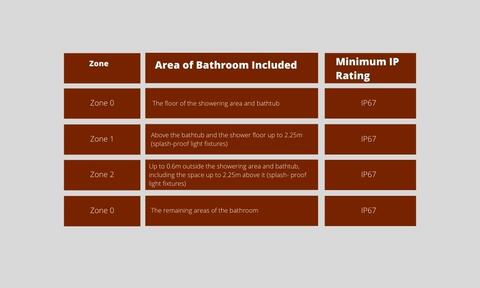
Optimal lighting is an essential part of any room in your home. But this is especially so when it comes to your bathroom. The reason is optimal lighting enhances the design, style, and furnishing of your bathroom.
This in-depth bathroom lighting guide presents you with not only valuable tips but also practical ideas you can implement today. And this is regardless of whether you are designing a new bathroom or renovating an existing one. Let’s start with a quick look at the types of bathroom lights and the basic types of lighting.
- Types of Bathroom Lights
- Basic Types of Lighting
- Bathroom Lighting Zones Explained
- Bathroom Lighting Energy Efficiency: LEDs Versus Halogens – The Better Alternative?
- How to Choose Bathroom Lighting?
- FAQs About Bathroom Lighting
Navigate to any section of this post by clicking on the links above.
Types of Bathroom Lights
Wall Lights
The right balance is the basic guideline of bathroom lighting. You need to blend natural light and well-oriented artificial light in the right proportion.
In bathrooms that lack natural light, you have to be careful. Harsh light can easily create an unfriendly atmosphere. But at the same time, a dark bathroom isn’t an easy place to navigate. This is where bathroom wall lights lend the perfect balance.
Wall lights spread light uniformly along the walls. Hence, bathroom wall lamps take care of the two essentials: general lighting and mirror area. The best place to install wall lamps is either over the washbasin or around the mirror.

Ceiling Lights
Ceiling lights provide your bathroom with a higher level of illumination than wall lights. Unlike wall lights that cover only one area, ceiling lights illuminate all the areas of your bathroom. The sheer variety of ceiling-mounted lights available today is mind-boggling. So, regardless of the style and decor of your bathroom, you are assured of finding the right ceiling lights.
At Bathroom City, we strive to stock ceiling-mounted fittings that reflect current and emerging trends. The range of size options also means you will find the perfect fit, whether your bathroom is a tiny one under the stairs or a large master bathroom.

Basic Types of Lighting
Bathrooms are usually smaller spaces compared to the other rooms in your home. Hence, you have modest-sized windows – sometimes none at all – and fewer options for light fixtures. You also have moisture to contend with.
All these factors mean the bulbs you pick will often have to serve several functions. They will need to act as a fine mixture of the three basic types of lighting: accent, ambient, and task lighting. Let’s take a closer look at each one of them.
Accent Lighting
Accent lighting adds depth and interest. You can use this type of lighting design to highlight the decorative elements in your bathroom. For instance, you can highlight the bathroom tile or artwork to enhance the overall atmosphere.
Choose light fixtures that provide focused illumination for the piece of art or architectural feature you want to show off. Some of the fixtures that you can angle and position to provide maximum flexibility include directional recessed lamps, wall lights, and track lighting.
Ambient Lighting
Ambient lighting is vital as it fills in for the natural light in your bathroom. The uniform level of light that ambient lighting presents is enough to steer through the room safely. Without this essential lighting, you’d be tripping over things.
This basic type of lighting typically comes from an overhead source. The best choices include pendant lamps, chandeliers, or recessed lighting. But you can also use sconces and other wall-mounted light fixtures.
Ambient lighting involves several fixtures, depending on the bathroom size. You can customise these lights by equipping them with dimmers. An important point to note is all bulbs are not compatible with dimmers. So you need to choose the right bulbs. Otherwise, the lifespan of the bulb will be shortened considerably.
Task Lighting
Task lighting, as the name suggests, is a bit self-explanatory. These lights make specific bathroom tasks easier. For instance, task lights illuminate the space around the mirror and vanity. Likewise, you can use these lights to illuminate the area near the shower enclosure and/or bathtub.
Task lighting enables you to see clearly. The primary aim is to provide a brighter level of light. You’ll find that performing the usual tasks such as dental care, putting on makeup, shaving and other everyday preparations become a breeze.
The best lights for task lighting provide focused light – directed right where you need it. Examples of task lights include a bath bar light or a pair of vertical sconces positioned on either side of the mirror.
Bathroom Lighting Zones Explained
IP Ratings
IP rating, represented by two characters, indicates the Ingress Protection. These two numbers typically refer to the protection level. This coding system shows the degree of protection provided against breaches by objects and body parts, such as fingers, as well as an intrusion by water and dust.
Although IP ratings appear unremarkable, you need to understand them well before you begin shopping for bathroom lighting. (This in-depth guide is NOT an installation guide. Please refer to the IEE Wiring Regulations, for detailed wiring regulations.)
The table below will help you choose the fixtures with the correct IP rating, depending on where you want to install them inside the bathroom.

Safety Standards
The guidelines for the installation of bathroom lighting in the UK are stringent. You need to ensure that the installation conforms to the stipulated safety standards.
Based on the bathroom zones, as explained in the table above, you can buy the lighting fixtures for your bathroom. Check the IP number on the fixtures and make certain you are ordering the lights that are most appropriate for their intended use.
Bathroom Lighting Energy Efficiency: LEDs Versus Halogens - The Better Alternative?
LEDs beat Halogens by a large margin when it comes to bathroom lighting energy efficiency. Halogen lights use almost 90% of their energy to emit heat. But LEDs emit only 10% of their energy in heat. Yes, that’s right. LEDs convert more than 80% of electrical energy to light.
So, the energy efficiency of LEDs is obvious. An average LED consumes about 10 watts of power compared to 60 watts of power that an average halogen consumes. LEDs are also better suited to frequent on-off operations compared to halogens.
Heat emission is also a huge safety factor in bathroom lighting. Halogen lights reach high temperatures, and inside a bathroom, they are dangerous. They can cause burns if touched accidentally. But since LEDs emit less heat, they are relatively cool to the touch.
How to Choose Bathroom Lighting?
Bright bathroom lighting is an essential element of good bathroom design. But you’ll need to be careful and avoid harsh light bulbs. The 5 factors discussed below are very important for creating a beautiful, functional space.
1. Amount of Natural Light Received
When choosing bathroom lighting, it’s wise to maximise natural light. After all, natural light is what you encounter in real life. So, if the windows are bringing in lots of natural light, the requirement for artificial lighting will be minimal.
You can install the bare minimum in such a case. But you cannot always control the amount of natural light that enters your bathroom. And windowless bathrooms are commonplace these days. If for any reason, the amount of natural light that streams into your bathroom is low, you can consider brightening things up.
The best option is LEDs from Philips. They deliver bright, white light that brightens your bathroom. The other main feature of these bulbs is their affordability. Also, the manufacturer promises a decade of daily use before the need for replacement arises.
2. Number of Users
When several members of your family use a bathroom, you’ll need a well-lit bathroom. While some people may prefer a long, relaxing soak in the bathtub, some may favour a quick shower. So, the focus will be on installing multiple light sources with well-defined purposes. Mix up the lighting a bit.
Install task lights to make applying makeup and shaving a pleasant experience. Select mood lighting to satisfy the cravings of your family members who prefer to relax in the bathtub. You could also include a couple of statement fixtures such as sconces or a chandelier for a more personalised space.
3. Size of the Bathroom
The right lighting options enable you to make a statement regardless of the size of your bathroom. If your bathroom is spacious, consider installing a chandelier. You can transform your bathroom into a palatial space. But if your bathroom is compact, then go for a cute pendant light. Just make sure it doesn’t gobble too much space.
Another old-fashioned bathroom lighting option is installing a single light source at the centre of the bathroom. You can only achieve a plain appearance when you do this.
A different way to do this would be placing lights near the windows, bathtub, showering area, and above or below the mirror. Also, instead of using one light, you can use multiple lights. Make your bathroom stand out by trying to emphasize every tiny detail.
4. Energy Efficiency
LEDs beat the competition hands down in regard to energy efficiency. The other thing is LEDs generate less heat compared to other light sources. So, when it comes to bathroom lighting, LEDs are doubtless your number one choice.
5. Desired Ambience
Chandeliers and pendants, the “wow” pieces, accentuate the style and personality of your bathroom. But simply installing them isn’t enough. There’s no guarantee that you’ll achieve the desired ambience. So, the best way to achieve your desired ambience is to experiment a bit.
Vary the height of your new lighting. Hang it high and check the ambience. See if the illumination of the different areas in your bathroom is alright. Next, lower the height of the lighting a bit. Check the ambience now. See if you have sufficient light for performing everyday tasks such as brushing your teeth and combing your hair. Settle for the height that satisfies you.
FAQs About Bathroom Lighting
How Bright Should Your Bathroom Lighting Be?
Phil Richards, a Senior Instructor & Lighting Educator at Juno Lighting Group, has a simple rule for the bathroom lighting brightness parameter. He says it’s your age plus 20. So, if you’re 30 years old, it would be 50fc (foot-candle). But someone in your family who is 50 years old would need 70fc to see equally well.
For reference, 1fc = 10.76 lumens/sq. ft. and the brightness of a 10w LED are 900 lumens. The reason is with advancing age, the eye’s pupil size reduces and the pupil lets in less light.
But if glare is an issue in your bathroom, you can solve it by using fixtures – lenses, deeply recessed down-lights, or up-lights − that mask the original light source. Dimmers are also immensely helpful. Hence, instead of lighting your bathroom inadequately, you can “overlight” it and provide dimmers for adjusting the brightness levels.
Is It Important to Use IP-Rated Lights in the Bathroom?
Yes, it is important to use IP-rated lights in your bathroom. When water and electricity are involved, it is better if you don’t leave anything to chance. Even a stray water splash can result in an electric fire. The risk is always high in a small bathroom. Hence, you must insist on IP-rated lights when you are making a purchase for a small bathroom.
However, if your bathroom or shower enclosure is large, it is easy to install lights away from high-risk places. Also, you have more choices in the light fixtures you can install. You can use ceiling lights that don’t have an IP rating as long as they’re not located directly over a bathtub or shower.
Since most ceiling lights tend to be in the middle of the bathroom, this shouldn’t be an issue. It will suffice if you use a flush or fixed fitting. The switch needs to be located outside the bathroom, or it can also be a ceiling pull switch.
What Colour Lighting Is Best for Bathrooms?
Neutral white is perfect for bright light. But the best colour that promotes relaxation is warm white. The most important factor you need to consider when buying bathroom lights is the CRI (Colour Rendering Index) of the bulbs. CRI is a measure of the degree of accuracy that a light source renders colours.
Light sources with a low CRI (for example, old fluorescent bulbs) won’t render colours accurately. They dim the colours in the room or tint them strangely. In a bathroom, a light source with a low CRI can make colours look unnatural. This can make a routine task, like applying makeup, very difficult. So, you need to choose light bulbs with a CRI in the range of 80 to 95.
What Is the Best Bathroom Lighting for Vanity Units?
Vanity units have cabinets and drawers that need enough lighting. Only then you can see an item easily and grab it quickly. This is true when you are in a hurry. Overhead lighting, especially recessed lamps, can work here. (A recessed lamp is typically installed into a hollow opening in the bathroom ceiling). But the best lighting for a vanity unit is under cabinet lighting which is commonly used in a kitchen.
For the best illumination, you can place LED strip lights below bathroom counters and cabinets. You can do that inside drawers, as well. An added advantage is these lights can help you in navigating your bathroom safely at night without switching on harsher lights.
What Is the Best Bathroom Lighting for Applying Makeup?
Professional makeup artists agree that natural daylight is the best bet for applying makeup. The next best option is white LED lights placed uniformly on either side of your vanity mirror. The prerequisite for applying makeup fast is you need to receive sufficient illumination along the length of your face.
Avoid fluorescent lighting, yellow lighting, and top lighting as they are not the right choice for full-face illumination. Also, remember that multiple weaker light sources are better than one strong light source.
Shop Bathroom Lighting
Clear visibility is a key factor in your bathroom. Remember, bad bathroom lighting can make your bathroom a dangerous place.
Bathroom City’s selection of bathroom lighting fixtures not only brightens your bathroom but also presents a wealth of styles. The range of size options from top brands means you are guaranteed to find the best lighting for your bathroom.
Other related articles you might also like to read: